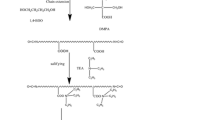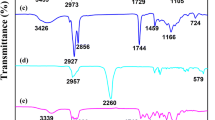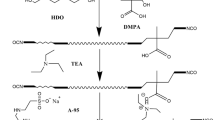Abstract
Waterborne polyurethane prepolymer was prepared by the reaction of isophorone isocyanate(IPDI), polyether polyol(PTMG), dimethylol propionic acid(DMPA) and trimethylol propane(TMP), which was modified by silicane coupling agent(APTES) to form highly crosslinked polyurethane emulsion. The films of the waterborne polyurethane were prepared. The structure of the polyurethane was characterized by Fourier transform infared spectrometer (FTIR), X-ray diffraction (XRD) and differential scanning calorimeter (DSC). The mechanical properties and water absorption of the films were measured. FT-IR indicates that APTES reacted with -NCO of polyurethane. XRD and DSC shows that crystallinity of polyurethane decreased with the increase of w(APTES). Tensile strength increases as the NCO/OH ratio increases. Tensile strength of films increases with increase of w(DMPA) and elongation at break decreases. The water absorption decreases with the increase of w(TMP) when w(TMP) is lower than 1.8%. As the mass fraction of APTES increases from 0% to 10%, the tensile strength of PU films increased from 18 MPa to 28 MPa, water absorption and ethanol absorption decreased.












Similar content being viewed by others
References
Bai C, Zhang X, Dai J (2008) Effect of the hard segment on the properties of UV curable waterborne blocked polyurethanes. J Polymer Res 15:67–73
Jeon HT, Jang MK, Kima BK (2007) Synthesis and characterizations of waterborne polyurethane-silica hybrids using sol-gel process. Colloid Surface Physicochem Eng Aspect 302:559–567
Cheng X, Chen Z, Shi T et al (2007) Synthesis and characterization of core-shell LIPN-fluorine containing polyacrylate latex. Colloid Surface 292:119–124
Jang JY, Jhon YK, Cheong IW (2002) Effect of process variables on molecular weight and mechanical properties of water-based polyurethane dispersion. Colloid Surface 196:135–143
Zequn Y, Qishan H, Jianming Y (2008) Technology development of high performance waterborne polyurethanes. Chinese Polymer Bulletin 9:20–29
Qingsi Z, Xiaoli Z, Tianduo L (2007) Prepara tion and properties of reactive aqueous polyurethane dispersion modified by polysiloxane. Petrochemical technology 36:839–845
Pierre C, Eric C, Henri C et al (2005) Synthesis of core-shell polyurethane-polydimethylsiloxane particles in cyclohexane and in supercritical carbon dioxide used as dispersant media: A comparative investigation. Polymer 46:1057–1066
Chen H, Fan Q, Chen D (2001) Synthesis and properties of polyurethane modified with an aminoethylaminopropyl-substituted polydimethysiloxane. J Appl Polymer Sci 79:295–301
Queiroz DP, de Pinho MN (2005) Structural characteristics and gas permeation properties of polydimethylsiloxane/ poly (propylene oxide) urethane/urea bi-soft segment membranes. Polymer 46:2346
Wang LF, Ji Q, Glass TE et al (2000) Synthesis and characterization of organosiloxane modified segmented polyether polyurethanes. Polymer 41:5083–5093
Jena KK, Raju KVSN (2007) Synthesis and characterization of hyperbranched polyurethane-urea/silica based hybrid coatings[J]. Ind Eng Chem Res 46:6408–6416
Wang LF, Ji Q, Glass TE et al (2000) Synthesis and characterization of organosiloxane modified segmented polyether polyurethanes. Polymer 41:5083–5093
Zhang T, Xi K, Yu X, Gu M, Guo S (2003) Synthesis, properties of fullerene-containing polyurethane–urea and its optical limiting absorption. Polymer 44:2647–2654
Blank WJ, Tramontano VJ (1996) Properties of crosslinked polyurethane dispersions. Progr Org Coating 27:1–15
Lucas HR, Mealmaker WE, Giannopouos N (1996) Novel polyurethanes with interpenetrating networks for the coating industry. Progr Org Coating 27:133–144
Acknowledgements
We would like to express our great thanks to the National Natural Science Foundation of China (grant number: 20876093) and the Graduate Innovation Fund of Shaanxi University of Science and Technology for financial support.
Author information
Authors and Affiliations
Corresponding author
Rights and permissions
About this article
Cite this article
Wang, L., Shen, Y., Lai, X. et al. Synthesis and properties of crosslinked waterborne polyurethane. J Polym Res 18, 469–476 (2011). https://doi.org/10.1007/s10965-010-9438-9
Received:
Accepted:
Published:
Issue Date:
DOI: https://doi.org/10.1007/s10965-010-9438-9




